


Deeper Into Space
ILM was approached midway through the post production period to supplement Sony's space work on the film. Squires told me, "when you begin your involvement in a show late in its production, it can be a difficult situation because the look and style of For effects houses ILM, Boss Film and POP Film, a major challenge was to match Sony's already produced look and feel to the space shots.
ILM executed its space sequences with model miniatures to represent the large vessels and elements, to match the look of Sony's space work. For the asteroid sequence, ILM created its 3 foot long asteroid model to match a previously built model by Boss Film Studios, "so we had to make sure that there was some continuity in how the two asteroids looked and moved," Squires remarked, "even though they are two different asteroids for two different scenes in the movie." The guns that appear from the lunar ring station were built in the same scale as ILM's lunar ring. Laser blast elements were created with digital animation. Squires added, "We also shot a pyro version of the asteroid, which we blew up, and then blended the two asteroids together in the compositing stage."
The lunar ring design was based on a mockup that director Verhoeven brought into ILM, which represented a design that he was looking for. The ring is a continuous station that circles the moon, and whose construction posed an interesting challenge. Squires said, "The idea was to create one section of the lunar ring, knowing that we would have to somehow replicate the surrounding sections to make it seem like it wraps around the moon. We knew we would replicate the ring digitally, but with all the moving camera shots, we wanted to stay away from that, so we simply offset the motion control camera and shot the same piece of ring model a number of times to create the illusion of a continuous station."
The interior of the ring was built with removable ceiling pieces, so the motion control camera could track the length of the model. Added to these shots was Carmen's transport pod. "The pod was made as a CG model. We looked at its movements and choreography, and thought, 'well we could build it and match all the angles to The greenscreen shots photographed by the production were "poorly lit, with excessive spill and numerous lighting rigs to remove." Anonymous
The next ILM sequence depicts Carmen piloting the Rodger Young out of spacedock. Squires remarked, "The idea of the scene was to establish the scale of the Rodger Young, as well as demonstrate Carmen's character as a hotshot pilot. We spent a lot of time setting up animatics, carefully working out the timing and framing of each shot until Paul was happy." ILM built a nine foot RY model and shot the docking bay (made in the same scale as the RY), "with the idea being that we could shoot both models at the same time. We did this not only to take advantage of creating only lighting setup, but also miminize some of the compositing stages down the line."
Carmen releases the docking cables only at the last possible moment. "Those cables are all CG," Squires said, "and the gas and vapor that appears are also digital particle effects. We also added some workers in spacesuits as CG models, too."
Squires also mentioned, "There were some technical problems with some of the greenscreen live action footage, so we had to spend a lot of time coming up with good mattes for those cockpit shots." This was a popular issue shared among a number of the effects houses--compositing poorly lit greenscreen elements. A compositor who wished to remain anonymous said "it was really, really tough working with those shots." Another said that the production's greenscreen shots were "poorly lit, with excessive spill and numerous lighting rigs to remove... the production flashed lights gelled blue as flashes, to simulate space explosions, and its affect on the glass canopies caused numerous problems when the we tried to matte out the greenscreens."
An isolated space sequence takes place as the Rodger Young approaches an asteroid heading straight into the ship. Evasive manuevers allow the ship to emerge unscathed. The daunting task of creating and shooting the effects elements for the sequence was taken by Boss Film Studios under the supervision of David Jones and Jim Rygiel, while compositing duties went to POP Film.
Dadras explained, "The live-action already had a camera move--a slow, steadicam tracking move. We took that footage, realizing that it was going to complete the shot, and then dove into creating the animatics, and after quite a few iterations, we settled on a final camera move."
The shot was to begin with the RY in full frame, "so in real space, the camera would have to begin its move a mile away from the ship," Dadras said. It would move toward the ship at an incredible rate of speed, decelerating near the end of its arc to eventually emulate the live action camera move. But this posed a problem, because the live-action footage's camera did not decelerate--it maintained a constant slow pace. Dadras said, "We came up with the idea to time convert the plate. When we first see the plate, it's going at about four times the real speed of the shot, and it slows to actual speed." The process enabled the shot to decelerate according to the new camera movement. "We worked closely with Ken Littleton at POP Film on the time conversion process."
But that was just the 'end' of the shot. Dadras explained the beginning and middle of the shot: "Once we got a move finalized in the animatics, we shot the model on stage." Although Boss built and utilized an 18 foot model of the RY for the sequence, the detail on the bridge's main window, only 1/2 inch tall, wouldn't hold
POP producer Andrea D'Amico told me, "The shot was quite an endeavor for Boss, the production unit, and our compositors because it was so complex. It was an enormous challenge to match the detail, both on Boss' and on our part, between the CG bridge and the model ship, and then to perfectly marry the live-action footage with the CG bridge. Hopefully, the audience will never realize the progression from model to CG to live-action, and they'll just accept the shot as reality."
As the sequence continues, a huge asteroid threatens the crew of the RY. Dadras said that Boss built two models: "Our hero asteroid was a complete asteroid which we rigged so that it could rotate in almost any position we wanted, and the other was a 22 foot model of a portion of the asteroid. It was the used for shots where the asteroid passes right over the RY or whenever it was really large in the foreground."
POP Film's team tackled some major issues, as well. D'Amico told me, "We generated the starfields in these shots that had to precisely match Sony's starfields which appear in their sequences. We also handled several thruster shots, which were extremely rendering intensive." Once again, matching the established look of Sony's work was an important task. "Our CG guys worked very closely with Sony's CG department to match the look of their 'main unit' thrusters. We actually used their shaders to create the blue, flaming thrusters in our shots."
The film's opening FedNet sequence features a short space sequence, documenting an approaching asteroid, on its way to Earth, as the lunar ring's weapons systems come on line and destroy the looming threat. The other lunar ring sequences, including Carmen's flight to the Rodger Young and her piloting the RY out of spacedock, and a duo of Ticonderoga space station sequences, were executed by Industrial Light & Magic, under the supervision of Scott Squires.
our shots would have to match to the other companies' work." In order to come up with a general look and style, Squires said "we asked to see as much approved footage and animatics as possible, so we could have some kind of guidance in that respect. What we ended up doing was handling entire sequences instead of bits and pieces of other sequences. The ultimate goal was to set up a situation where our shots never had to be intercut with another company's shots."
the lunar ring shots', but given the types of moves it was going to be making in the ring and outside of it, we ultimately decided to go with a CG model."
The first shot of the sequence is probably the most ambitious of the entire sequence; the camera makes an enormous camera move, eventually revealing the pilots inside the bridge, viewed through the bridge's main window. Tom Dadras, Boss' digital effects supervisor for TROOPERS, recollects developing the shot: "In a perfect world, we would have designed the shot from start to finish, and dictated how all the elements would work." When Boss began work on the project, the live-action element had already been shot, so Boss couldn't have any input into the shot's design. "In this case, we were essentially handed a single element, the live-action footage of the cockpit, and had to work backwards from that point, and design the shot around that footage."
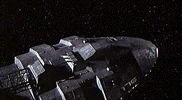
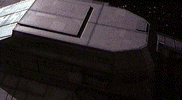
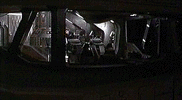
The three stages of the RY bridge--from model to 3D model to live action. Models by Boss, compositing by POP Film.
up to scrutiny with the camera so close to the model. The solution was to create a 3D model of the bridge section that would replace the model bridge at a certain point in the camera move. "The 3D bridge had to be precisely match moved to the model photography, as well as precisely matching the live action that would be integrated," remarked Dadras. The CG model was based on a digitized portion of the model (scanned by Viewpoint) and the texture paintings were done by Sassoon Film Design.
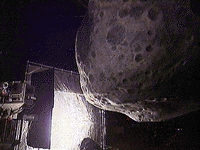
On Boss' motion control stage, shooting the hero asteroid model.
Shooting the asteroid and the 18 foot model of the RY was also a challenge. "The asteroid model that makes impact with the RY in a different scale as the ship itself," Dadras explained, "so the two elements were shot separately on different stages. We had to do a lot of planning to choreograph the action just right, and carefully plan the interactive lighting and shadows so that the two different models, shot separately and built at different scales, would convincingly look like they were occupying the same space."
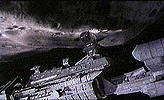
The asteroid nails the RY, emitting sparks, explosions and creating interactive light and shadows on both the asteroid and the RY.

Home - Who - Review - How - Pics: Bugs, Space, More

. . VFX HQ Produced by Todd Vaziri . . http://www.vfxhq.com . . e-mail: tvaziri@gmail.com . .
All text Copyright © 1998 Todd Vaziri, unless otherwise noted